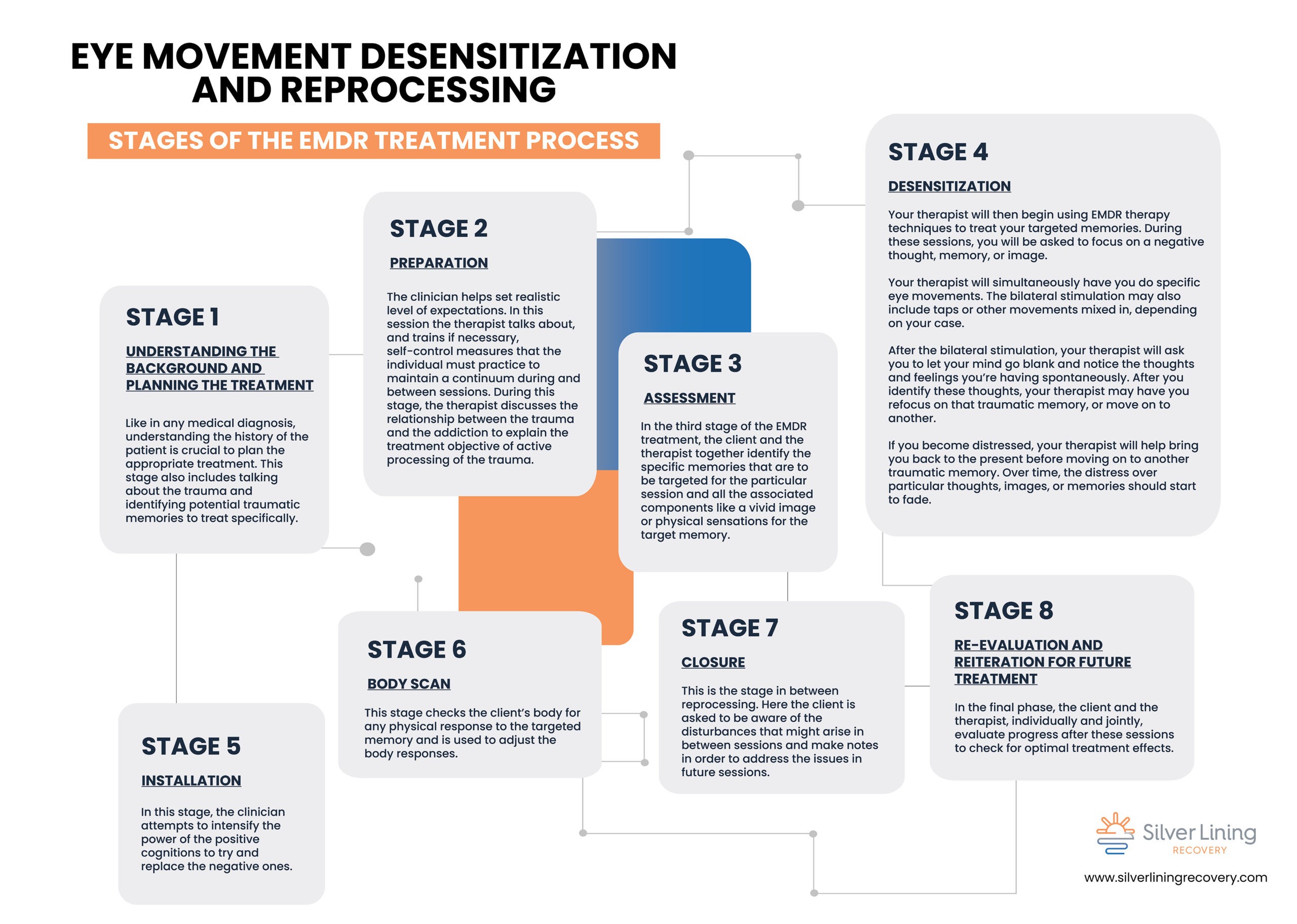

Transform Your Life with EMDR Therapy
Life is a series of experiences, both positive and negative, that shape our consciousness and influence our daily choices. Unfortunate events such as emotional distress, hostility, abuse, or neglect can lead to serious repercussions later in life, including addiction, chronic low self-esteem, and mental illness.
Eye Movement Desensitization and Reprocessing (EMDR) therapy is a well-established treatment based on robust psychotherapy principles, designed to help individuals suffering from Post-Traumatic Stress Disorder (PTSD). Recent clinical evidence supports the effectiveness of EMDR in treating various conditions, including anxiety, pain management, addiction recovery, phobias, and even dermatological disorders.
Explore how EMDR therapy at Silver Lining Recovery can help you process traumatic memories, replace negative emotions with positive ones, and foster healthier habits and relationships. Discover a path to healing and transformation today.
What is EMDR ?
Eye Movement Desensitization and Reprocessing (EMDR) is psychotherapy designed and developed by Dr.Francine Shapiro that uses techniques such as eye and hand movements to assist individuals in removing negative associations during regular personal interactions. The therapy aims to help a person change behavior to tame the problems in the anticipated ways. It was originally developed to attend to post-traumatic stress, anxiety, and phobias manifestations.
The Theory Behind EMDR Treatment
The EMDR therapy relies on the Adaptive Information Processing (AIP) model (Shapiro, 2001a) to elucidate and predict the efficacy of the treatment. Shapiro F. (2001a). Eye Movement Desensitization and Reprocessing – Basic Principles, Protocols, and Procedures. New York, NY: Guilford. One of the key beliefs of the AIP model is the understanding that like our body recovers from a physical wound by virtue of the body’s internal mechanism; our mind also repairs the mental wounds inflicted during negative interactions. The multiple elements of each experience are processed and stored as memories in an accessible and usable form. Memories have a linked network of images, thoughts, sensations, and emotions. When new associations are made with already stored elements in the memory, learning takes place.
During an adverse traumatic incident, the information processing function may get compromised because of the excessive negative feeling interfering with the process. As a result, the memory is cached without the correct associative connections. These incompletely stored memories that are not entirely processed become the cause of numerous mental disorders, including Post-Traumatic Stress Disorder (PTSD), chronic addiction, affective disorders, chronic pain, and phobias.
Eye Movement Desensitization and Reprocessing (EMDR) Therapy
EMDR therapy sessions involve revisiting traumatic experiences or triggers in brief, controlled doses, as agreed upon with your therapist. During these sessions, the therapist uses hand movements and other tactile techniques to guide the individual’s eye movements side by side. This may include viewing a pendulum swing or hand tapping, among other sensory inputs.
The goal of Eye Movement Desensitization and Reprocessing (EMDR) therapy is to process dysfunctional memories by linking them to more adaptive information. This process helps reframe the experience with appropriate emotions, allowing the person to understand and process past encounters in a safe environment. Negative emotions are gradually replaced by positive sentiments, promoting healthier habits and relationships.
Stages of the EMDR treatment process
Eye Movement Desensitization and Reprocessing therapy is an eight-stage treatment.
Stage 1: Understanding the background and planning the treatment
Like in any medical diagnosis, understanding the history of the patient is crucial to plan the appropriate treatment. This stage also includes talking about the trauma and identifying potential traumatic memories to treat specifically.
Stage 2: Preparation
The clinician helps set realistic level of expectations. In this session the therapist talks about, and trains if necessary, self-control measures that the individual must practice to maintain a continuum during and between sessions. During this stage, the therapist discusses the relationship between the trauma and the addiction to explain the treatment objective of active processing of the trauma.
Stage 3: Assessment
In the third stage of the EMDR treatment, the client and the therapist together identify the specific memories that are to be targeted for the particular session and all the associated components like a vivid image or physical sensations for the target memory.
Stage 4: Desensitization
Your therapist will then begin using EMDR therapy techniques to treat your targeted memories. During these sessions, you will be asked to focus on a negative thought, memory, or image.
Your therapist will simultaneously have you do specific eye movements. The bilateral stimulation may also include taps or other movements mixed in, depending on your case.
After the bilateral stimulation, your therapist will ask you to let your mind go blank and notice the thoughts and feelings you’re having spontaneously. After you identify these thoughts, your therapist may have you refocus on that traumatic memory, or move on to another.
If you become distressed, your therapist will help bring you back to the present before moving on to another traumatic memory. Over time, the distress over particular thoughts, images, or memories should start to fade.
Stage 5: Installation
In this stage, the clinician attempts to intensify the power of the positive cognitions to try and replace the negative ones.
Stage 6: Body Scan
This stage checks the client’s body for any physical response to the targeted memory and is used to adjust the body responses.
Stage 7: Closure
This is the stage in between reprocessing. Here the client is asked to be aware of the disturbances that might arise in between sessions and make notes in order to address the issues in future sessions.
Stage 8: Re-evaluation and reiteration for future treatment
In the final phase, the client and the therapist, individually and jointly,evaluate progress after these sessions to check for optimal treatment effects.
At Silver Lining, the process measures that we ardently follow during the implementation of EMDR treatment at our Orange County, California, facility are aimed to support quality programs that:
- Provide the conducive environment to our patrons to initiate and facilitate the self-exploration process.
- Assists our clinicians to help individuals in self-reflection, discussion, and building of continuing collaborations among the healing population.
- Focus on an individual’s holistic healing in all spheres of their life – social, physical, emotional, creative and cognitive.
- Establish receptive and positive relationships.
- Engage with their families and learn to appreciate their unique perspectives and contributions.
- Use documentation to study, interpret and make visible the healing process of individuals.
These approaches support the individuals as they learn to accept and move beyond their own deep-rooted negative beliefs along a developmental continuity and make way for a smoother transition from negativity to acceptance to ultimate positivity.

Who is Not a Good Candidate for EMDR?
EMDR is not suitable for individuals who do not experience issues related to traumatic events, PTSD, or other forms of emotional distress. Different therapeutic approaches may be more appropriate for your needs if you do not have these specific concerns.
Start Your Healing Journey Today
If you or a loved one are struggling with the aftermath of trauma, PTSD, or emotional distress, Eye Movement Desensitization and Reprocessing (EMDR) therapy at Silver Lining Recovery can provide the support and relief you need. Our compassionate team is dedicated to helping you process difficult memories, replace negative emotions with positive ones, and develop healthier habits and relationships.
Don’t let past experiences control your future. Take the first step towards healing and transformation. Contact us today to learn more about our EMDR therapy program and schedule a consultation. Your path to a brighter, healthier future begins here.
Reach out to Silver Lining Recovery now to start your journey towards healing. Call us at 866-681-0927 or visit our Contact Us page to schedule your consultation today.






